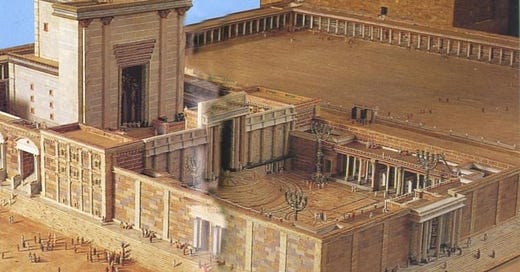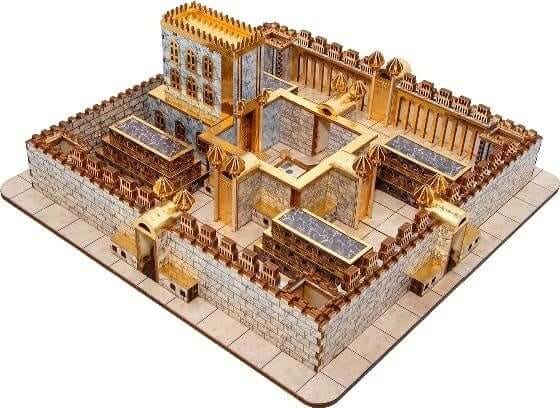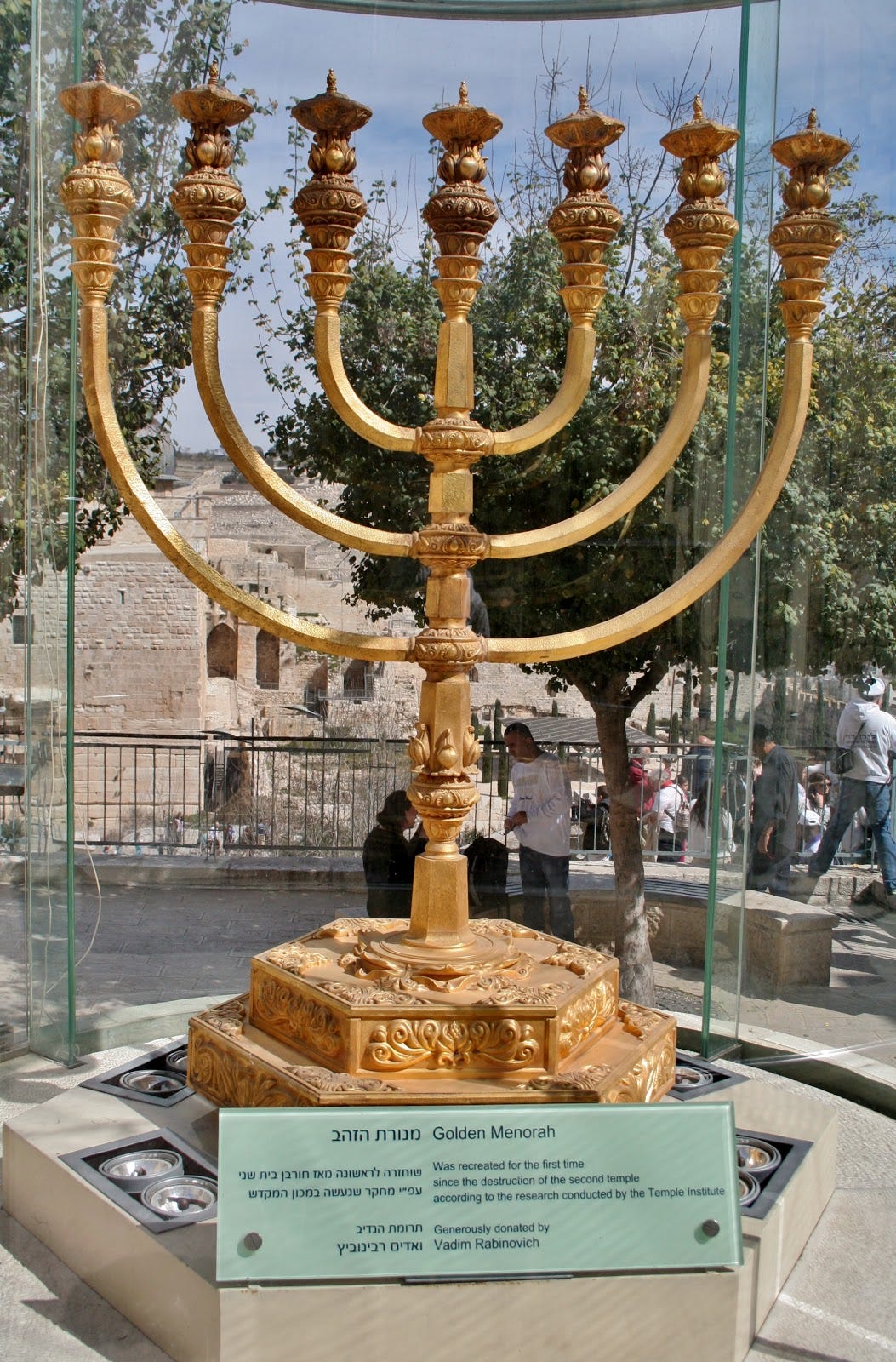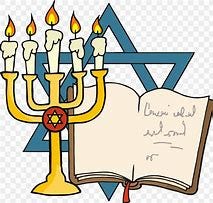When evening comes, you say, ‘It will be fair weather, for the sky is red,’ and in the morning, ‘Today it will be stormy, for the sky is red and overcast.’ You know how to interpret the appearance of the sky, but you cannot interpret the signs of the times.
Matthew 16:2-3
As we near the conclusion of Hanukkah in 2023, it seems a fitting time to publish a piece concerning the Third Jewish Temple, a topic shrouded in both historical significance and eschatological speculation.1
Hanukkah, known as the Festival of Lights, commemorates the rededication of the Second Temple in Jerusalem in 164 BC and celebrates the triumph of light over darkness, spirituality over materialism. As Hanukkah inspires reflection on the past and present sanctity of the Temple in Jewish tradition, we aim to explore the possibilities and implications of rebuilding the Third Temple in contemporary times.
There is a prevailing expectation among Christians and Jews alike that the construction of a Third Temple in Jerusalem is a pivotal event in the fulfillment of end times prophecy. This belief is not merely theoretical; it has found widespread practical expression, perhaps most notably in the efforts of an organization called The Temple Institute.
Located in the historic heart of Old Jerusalem, this organization has dedicated over three decades to the meticulous preparation for a new temple. Their endeavors extend well beyond fundraising to include the development of detailed architectural plans among other necessities integral to the envisioned Third Temple.
The Temple Institute is dedicated to making the Holy Temple a reality in our day, and toward this end, the Temple Institute has, for 36 years, been building and planning and researching and teaching and sharing with you our reconstructed sacred vessels and priestly garments, our books and paintings, our red heifer candidates, our teachings and insights and our love for Hashem and the Holy Temple!2
This ambitious project, however, is steeped in controversy and theological debate. A significant faction within the religious community, both Judaic and Christian, contends that the construction of the Third Temple is a divine prerogative, not a human endeavor.
This article will delve into the various interpretations of prophecies concerning the Third Temple and explore diverse perspectives ranging from fervent advocacy to cautious opposition. We will critically examine the putative biblical imperative for the Temple's construction in relation to the anticipated coming or return of the Messiah. This branch of theology is called eschatology.
Is The Third Jewish Temple Ezekiel’s ‘Millennial’ Temple?
In eschatological discussions within Judeo-Christian traditions, there is often an association made between the concept of the Third Jewish Temple and the Millennial Temple, the latter being detailed in the Book of Ezekiel. However, interpretations of these temples vary among scholars and religious traditions, leading to different views on whether they represent the same entity or two distinct structures.
The Third Jewish Temple, in Jewish eschatology, is envisaged as a future temple to be erected in Jerusalem. This expectation arises not from a single explicit biblical prophecy, but rather from a synthesis of various interpretations of both biblical texts and rabbinic literature. The timing of its construction is debated, with some envisioning it as a precursor to the Messianic era,3 while others regard it as a significant feature of the Messiah's arrival.
In contrast, the Millennial Temple, as described in Ezekiel chapters 40-48, is depicted as a grand and detailed structure, which some interpret to be a temple built in a future Messianic era. Others, however, interpret Ezekiel's vision as a legitimate blueprint for the Third Temple.
Ezekiel meticulously describes measurements, design specifications and ceremonial practices associated with this envisioned temple. This extensive detail includes dimensions of gates, courts, chambers and altars, among other architectural features. It’s reported that the Temple Institute draws no distinction between the Third Temple and the temple described by Ezekiel.
The word eschaton is often defined as the end of an age, the end of history or the perfection of the world. Below are the the main prophecies that point to Third Temple eschatology:
Ezekiel's Temple (Ezekiel 40-48) - These chapters provide a description of a future temple, its dimensions and its functions that we’ve previously detailed.
Daniel's Prophecy (Daniel 9:24-27) - This passage includes the "Seventy Weeks" prophecy, which some interpret as including the rebuilding of a temple in Jerusalem. The exact timeline is subject to various interpretations, often linked to end time scenarios. This passage also refers to “the abomination that causes desolation,” (see footnote #3).
The Temple in the End Times (2 Thessalonians 2:3-4) - This New Testament passage from St Paul describes "the man of lawlessness" sitting in the temple of God, which some interpret as implying a future temple in Jerusalem. Paul’s prophecy is perhaps the source of the greatest controversy and deserves a more thorough analysis.
Paul’s Prophecy in Thessalonians
This prophecy, more so than the others, exercises Christian Zionism’s excitement for building the Third Temple as soon as obstacles to its location on the Temple Mount are overcome.
In 2 Thessalonians 2:4, the Greek word used by Paul for temple is ναός (naos). This word can indeed be translated as "temple," and in the context of ancient Greek and Biblical usage, "ναός" typically refers to the inner sanctuary or the most sacred area of a temple, where the deity is believed to dwell.
However, in the context of the New Testament, ναός is used both to refer to the physical Temple in Jerusalem and, metaphorically, to describe the community of Christian believers. For instance, in Corinthians Paul uses ναός to describe believers as the temple of God.
Don’t you know that you yourselves are God’s temple and that God’s Spirit dwells in your midst? If anyone destroys God’s temple, God will destroy that person; for God’s temple is sacred, and you together are that temple.
1 Corinthians 3:16
This dual possibility suggests why this passage is subjected to diverse understandings, ranging from a literal view anticipating a physical end times Third Temple, to a metaphorical view seeing the "temple of God" as symbolic of a greater spiritual community. Of course, it could be both as the two understandings are not mutually exclusive.
After the destruction of the Second Temple in AD 70, Rabbinical Judaism evolved significantly. The rabbis reinterpreted many religious practices to adapt to a world without a temple. Prayer, study and ethical living became central to Jewish religious life, replacing the temple’s ritual sacrifices.
Many Jewish scholars and communities argue that this evolution represents a maturation of the faith, moving away from the ancient sacrificial system towards a more spiritual and ethical religious expression. This would further obviate the need for a Third Temple in our times.
Other Motivations and Considerations
There are indeed some who see construction of the Third Temple as a way to hasten the coming (or return) of the Messiah. This belief is more prevalent among certain groups within Orthodox Judaism and Evangelical Christianity that interpret Biblical and rabbinic prophecies literally. They regard the rebuilding of the Temple as a necessary step in the messianic process.
For the most part, Christian Zionists enthusiastically support the idea of rebuilding the Temple, viewing it as the fulfillment of Christian eschatological prophecies concerning the end times and Second Coming of Christ. Their support is typically rooted in a specific interpretation of Christian scripture, a subject beyond the scope of this essay.
Many in this Christian group wish to see the temple rebuilt as a means of hastening the return of Christ. This sentiment might be considered a presumptuous interpretation of Holy Scripture that oversteps human bounds and meddles with divine providence.
Regarding the scriptural admonishment, "I prefer obedience, not sacrifice" (found in 1 Samuel 15:22 and echoed in Hosea 6:6, and other places), this sentiment reflects a theme present in both Jewish and Christian scripture: God values moral conduct and sincere devotion over ritual observance.
Moreover, this perspective is a key reason why many in the Jewish community do not see the rebuilding of the Temple and the resumption of sacrifices as necessary or desirable.
Orthodox Judaism, including the Haredi (ultra-Orthodox) community, holds a significant and influential position in Israeli religious and public life. Many in this community believe that human-initiated efforts to rebuild the Temple are audacious and should be undertaken only by the Messiah in the Messianic era. This perspective stems from belief in divine providence and a reluctance to coerce prophetic fulfillment.
Chabad-Lubavitch, a growing Hasidic movement within Orthodox Judaism, has its own perspective on the Third Temple controversy. Like many in the Orthodox Jewish world, Chabad believes in the eventual coming of the Messiah followed by rebuilding of the Temple. However, they do not advocate for premature efforts to rebuild the Temple.
Building the Third Temple in Jerusalem would carry immense risks of intensifying religious conflict, both within and beyond the region. The Temple Mount, where the Third Temple would stand, is considered holy by Jews, Christians and Muslims. The Al-Aqsa Mosque and Dome of the Rock shrine currently occupy the site.
Construction on the Temple Mount by Christians and Jews would be seen as an untenable provocation.4 Even today, Jews are permitted to access the Temple Mount only at certain times of the day and are not allowed to pray there.
Jewish religious authorities prohibit or discourage Jews from entering the Temple Mount due to religious purity laws. According to traditional Jewish law, one must be ritually pure to enter the area where the Holy of Holies once stood. Ritual purity can only be attained with the ashes of an unblemished red heifer, as described in Numbers Chapter 19. We wrote about the Red Heifers here.
The unblemished heifer must be completely red, with no more than two non-red hairs. The color must be a specific shade of red and any notable variation disqualifies the animal. These requirements were strictly adhered to during the Second Temple period (516 BCE – 70 CE).
Five qualified red heifers were transported to Israel in September 2022 courtesy of a Christian rancher in Texas. They are being housed at the ancient Shiloh heritage site where the biblical Tabernacle once stood.5
The Eschaton/Eschatology refers to the final age and culmination of history in various religious and philosophical traditions. It points to a New Age and typically involves: the ultimate triumph of good over evil; the reward for the righteous, often in a paradise or new heaven and earth, and the end of the current world as we know it and the beginning of something new. It does not imply the end of the world, only the end of an age.
The Temple Institute (website)
The Messianic Era in Jewish eschatology refers to a future period of time on earth when the Messiah will reign, bringing about universal peace, prosperity and spiritual enlightenment. This era is characterized by the gathering of the Jewish people back to the land of Israel, the rebuilding of the Temple in Jerusalem and the establishment of God's kingdom on earth, marked by a harmonious existence among all nations.
The Abomination That Causes Desolation
From the time that the daily sacrifice is abolished and the abomination that causes desolation is set up, there will be 1,290 days. Daniel 12:11 The Abomination of Desolation, also rendered as “The Abomination that causes Desolation,” is a controversial term found in the Bible that has sparked a wide range of speculative i…









Meanwhile more than two thirds of the worlds human population are neither Jewish or Christian.
Why does everything have to turn out to be Christian or based on the now archaic tribalistic cultic fantasies?
Meanwhile there is now a world-wide war being dramatized all over the planet, but specifically focused on the collective lunatic asylum of the Middle East and Israel/Palestine in particular. A war based on the desire and political intentions/machinations of the three "great" Semitic religions to control the entire world.